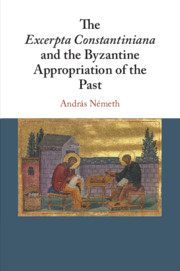Book contents
- The Excerpta Constantiniana and the Byzantine Appropriation of the Past
- The Excerpta Constantiniana and the Byzantine Appropriation of the Past
- Copyright page
- Contents
- Illustrations
- Tables and Maps
- Acknowledgements
- A Note on Text
- Abbreviations
- Introduction
- Chapter 1 Imperial Court and Knowledge Production
- Chapter 2 Appropriation of the Past
- Chapter 3 Constructing a Research Engine of the Past
- Chapter 4 Information Management in Constantine VII’s Treatises
- Chapter 5 Renewal of Historiography under Constantine VII
- Chapter 6 Distortion and Expansion of the Past in the Excerpta
- Chapter 7 Classification of the Past in the Excerpta
- Chapter 8 The Reading of the Excerpta
- Chapter 9 The Suda
- Conclusions
- Appendices
- Bibliography
- Manuscripts Index
- Names Index
- Subject Index
- References
Bibliography
Published online by Cambridge University Press: 28 September 2018
- The Excerpta Constantiniana and the Byzantine Appropriation of the Past
- The Excerpta Constantiniana and the Byzantine Appropriation of the Past
- Copyright page
- Contents
- Illustrations
- Tables and Maps
- Acknowledgements
- A Note on Text
- Abbreviations
- Introduction
- Chapter 1 Imperial Court and Knowledge Production
- Chapter 2 Appropriation of the Past
- Chapter 3 Constructing a Research Engine of the Past
- Chapter 4 Information Management in Constantine VII’s Treatises
- Chapter 5 Renewal of Historiography under Constantine VII
- Chapter 6 Distortion and Expansion of the Past in the Excerpta
- Chapter 7 Classification of the Past in the Excerpta
- Chapter 8 The Reading of the Excerpta
- Chapter 9 The Suda
- Conclusions
- Appendices
- Bibliography
- Manuscripts Index
- Names Index
- Subject Index
- References
- Type
- Chapter
- Information
- Publisher: Cambridge University PressPrint publication year: 2018



